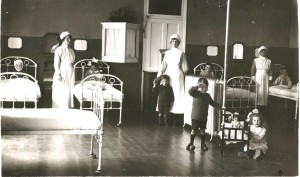There were many individuals that contributed to the successful running of Stannington Sanatorium and helped to make it the thriving institution that it was. This week we will have a look at the role of one of these individuals, Mary Ann Fulcher, headmistress of the Sanatorium School.
Mary Ann Fulcher served as the headmistress of Stannington Sanatorium School for over 32 years from 1st February 1921 up to her retirement on 18th December 1953. During her time as headmistress she presided over the school’s transition to state control and away from the management of the Poor Children’s Holiday Association following the passing of the National Health Act as well as witnessing the effects of WWII with the bombing of the sanatorium and its temporary relocation to Hexham.
In the annual report of 1938 Miss Fulcher details the work of the sanatorium school and the effect of illness upon the children:
‘Every other Friday a fresh group of children enters the Sanatorium School. behind each lies a little tragedy; weeks of ill-health followed by a visit to a doctor, then another consultation, and finally a parting from the old, familiar, well-loved things to enter a strange new world, and in the midst of the newness and strangeness they meet with a school and they all know something about schools, even if it is not quite the same as those they have known. About the school they are critical for they have a standard by which to judge. This big fellow says firmly, “I have left school,” and infers that he has put away with such childish things. The secondary school girl, until her health gave way, had had dreams of examination successes and is a little superior in her manner. Ill-health seems to her such an unfair handicap, and she half resentfully wonders what this school has to offer her …
Different in all, save that they are infected with tuberculosis, they come into the melting pot of school and it is the aim of the school, not so much to teach this fact or that, as it is to help all to face life with courage and to demonstrate that in spite of an early introduction to ill-health and suffering, the world is full of beauty and joy. …
The Sanatorium does not only attend to the children’s physical ills but adjusts their mental outlook … From time to time we hear of their achievements in the great outside world and are content.’ [HOSP/STAN/1/3/5]
![Open Air School. Class II Writing Lesson. [HOSP/STAN/11/1/27]](http://www.northumberlandarchives.com/wp-content/uploads/2015/01/HOSP-STAN-11-01-27-202x300.jpg)
Miss Fulcher’s work was recognised in the 1951 New Year’s Honours List when she was awarded an MBE for her service to the school. In the same year the school inspector’s report, recorded in the log book, gives a glowing report of her work and reads as such:
‘The Head Mistress, who has almost completed her thirtieth year of devoted service to the school, has never allowed the isolation of the premises or the specialised character of her work to cut her off from the main stream of educational interests. She shows close acquaintance with modern school practices & recent literature. She is a capable organiser in a complex field, maintains a good sense of proportion, leads her staff well, & imbues them with her inflexible regard for good standards of work. Her relations with the children are good, & she has equal regard for the needs of the youngest & the oldest. Her personal integrity, courage & humanity are pillars of support to the school.’
![NRO 10321-3 [MAG P4]](http://www.northumberlandarchives.com/wp-content/uploads/2015/03/NRO-10321-3-MAG-P4.jpg)


